Integrated Analysis of the 3D Geostress and 1D Geomechanics of an Exploration Well in a New Gas Field
Abstract
:1. Introduction
- (1)
- First, for a pilot well, such as the LT-1 well, in newly planned oil and gas blocks under investigation, there are no offset wells and no logging data available from the undrilled formations. The geomechanical analysis of the data and the further calculation of the mud window can only use the numerical results of the 3D geostress field for relevant analysis;
- (2)
- Second, when the ‘normal fault stress pattern’ appears within formations of the target block, the upper bound of the mud weight window is determined by the value of minimum horizontal stress. When a ‘reverse fault stress pattern’ appears, the upper bound of the mud weight window is determined by the value of overburden stress. In the oil and gas field at the southern edge of the Junggar Basin, due to the significant variation in elevation of the formation top, in different well sections of the same well, the ‘normal fault stress pattern’ and the ‘reverse fault stress pattern’ may exist at the same time: the upper part of the well section is in a normal fault stress pattern, the middle part is in a reverse fault stress pattern, and the lower part is again in a normal fault stress pattern. As a result, the analysis of the mud weight window obtained by the 1D analytical method is not accurate enough. So, it is necessary to use the numerical solution of the 3D geostress field to accurately calculate the mud weight window for a pilot well.
2. Materials and Methods
2.1. Overview of the Geology of the Target Block
2.2. Workflow of the Integrated 1D Geomechanical Analysis of the Pilot Well and the 3D Geostress Analysis
- (1)
- To build a geological model with input from the seismic data of the target block;
- (2)
- To perform a finite element analysis to obtain the numerical solution of the 3D geostress field;
- (3)
- The third step was the prediction of pore pressure. Tasks to be performed in this step included: (1) Extracting the formations’ interval velocity from the seismic data of the block and transferring it to sonic data; (2) Extracting the overburden pressure from the 3D geostress field and combining it with the sonic data to calculate the pore pressure curve. The Eaton’s method equation for the calculation of pore pressure is shown in Equation (1).where PP is pore pressure; OBG is the overburden gradient; ES is effective stress; PPGN is the hydrostatic pressure gradient, PPGN = 1.03 g/cm3; is the sonic data; is the sonic data of the normal compaction trend line; and E is the exponential index. The default value is 2.7. In the calculation presented here, the OBG is the vertical component of the 3D geostress of the target block;
- (4)
- The fourth step was to synthetically use the solution of the 3D geostress of the target block and the 1D solution of the pore pressure of the pilot well to calculate the mud weight window of the target well.
3. Results of 3D Geostress and 1D Geomechanical Analysis
3.1. Numerical Solution of 3D Geostress Field in TS Block
3.1.1. Finite Element (FE) Model
- The bottom surface and four side surfaces have normal zero displacement boundaries;
- The top surface is the ground and is a free surface.
3.1.2. The 1D Geomechanical Analysis of the Tugu-1 Well and Initial Input Data for the 3D FE Model
3.1.3. Numerical Solution of the 3D Geostress Field of the Target TS Block
3.2. Pore Pressure and Mud Weight Window Prediction of the LT-1 Well Based on 3D Geostress and Layer Velocity
3.2.1. Pore Pressure Prediction
3.2.2. Calculation of the Mud Weight Window for Safe Drilling
4. Discussion
5. Conclusions
Author Contributions
Funding
Data Availability Statement
Conflicts of Interest
References
- Gao, Z.Y.; Shi, Y.X.; Feng, J.R.; Zhou, C.M.; Luo, Z. Lithofacies paleogeography restoration of Jurassic to lower Cretaceous in southern margin of Junggar Basin, NW China. Pet. Explor. Dev. 2022, 49, 20220204. [Google Scholar] [CrossRef]
- Lin, Z.; Sun, Z.; Hu, H.; Xu, K.; Lei, C. Pore pressure distributional characterization of shale gas reservoir in WR block of Sichuan basin. Prog. Geophys. 2021, 36, 2045–2052. [Google Scholar]
- Chilingar, G.V.; Serebryakov, V.A.; Robertson, J.O., Jr. Origin and Prediction of Abnormal Formation Pressures, Development in Petroleum; Science Book Series; Elsevier: Berkeley, CA, USA, 2002; Volume 50. [Google Scholar]
- Shen, G.Y.; Clemmons, C.; Shen, X.P. Integrated 1-D workflow for pore-pressure prediction and mud weight window calculation for subsalt well sections. In Proceedings of the 49th US Rock Mechanics/Geomechanics Symposium, San Francisco, CA, USA, 28 June–1 July 2015. Paper NoARMA 15-097. [Google Scholar]
- Xu, J.L.; Wang, J.; He, D.B. A method for calculating pore pressure coefficient directly using ADCIGS. In Proceedings of the CPS/SEG International Geophysical Conference & Exposition, Beijing, China, 24 April 2018. Electronic Papers. [Google Scholar]
- Uhunoma, O.A.; Olalere, O. Combining porosity and resistivity logs for pore pressure prediction. J. Pet. Sci. Eng. 2021, 205, 108819. [Google Scholar]
- Wang, Z.C.; Wang, R.H. Pore pressure prediction using geophysical methods in carbonate reservoirs: Current status, challenges and way ahead. J. Nat. Gas Sci. Eng. 2015, 27, 986–993. [Google Scholar] [CrossRef]
- Mannon, T.; Salehi, S.; Young, R. Seismic frequency versus seismic interval velocity based pore pressure prediction methodologies for a near salt field in Mississippi Canyon, Gulf of Mexico: Accuracy analysis and implications. In Proceedings of the IADC/SPE Drilling Conference and Exhibition, Fort Worth, TX, USA, 4–6 March 2014. Paper No SPE 167915-MS. [Google Scholar]
- Cai, W.J.; Deng, J.D.; Zhang, J.F. Three-dimensional pore pressure prediction and visualization of reef limestone reservoirs in Indonesia A oilfield. Sci. Tech. Eng. 2021, 21, 8863–8869. (In Chinese) [Google Scholar]
- Mouchet, J.P.; Mitchell, A. Abnormal Pressure while Drilling; Editions Technip.: Paris, France, 1989. [Google Scholar]
- Wang, H.T.; Kou, Z.H.; Guo, L.L.; Chen, Z.T. A semi-analytical model for the transient pressure behaviors of a multiple fractured well in a coal seam gas reservoir. J. Pet. Sci. Eng. 2021, 198, 108159. [Google Scholar] [CrossRef]
- Kou, Z.H.; Zhang, D.X.; Chen, Z.T.; Xie, Y.X. Quantitatively determine CO2 geosequestration capacity in depleted shale reservoir: A model considering viscous flow, diffusion, and adsorption. Fuel 2022, 309, 122191. [Google Scholar] [CrossRef]
- Kou, Z.H.; Wang, H.; Alvarado, V.J.; McLaughlin, F.; Quillinan, S.A. Method for upscaling of CO2 migration in 3D heterogeneous geological models. J. Hydrol. 2022, 613, 128361. [Google Scholar] [CrossRef]
- Dassault Systemes. Abaqus Analysis User’s Manual, 14th ed.; Dassault Systemes Simulia Corp.: Providence, RI, USA, 2011; Volume IV. [Google Scholar]
- Shen, X.P.; Williams, K.; Standifird, W.B. Enhanced 1D prediction of the mud weight window for a subsalt well, deepwater GOM. Soc. Pet. Eng. J. 2014, 9. [Google Scholar] [CrossRef]

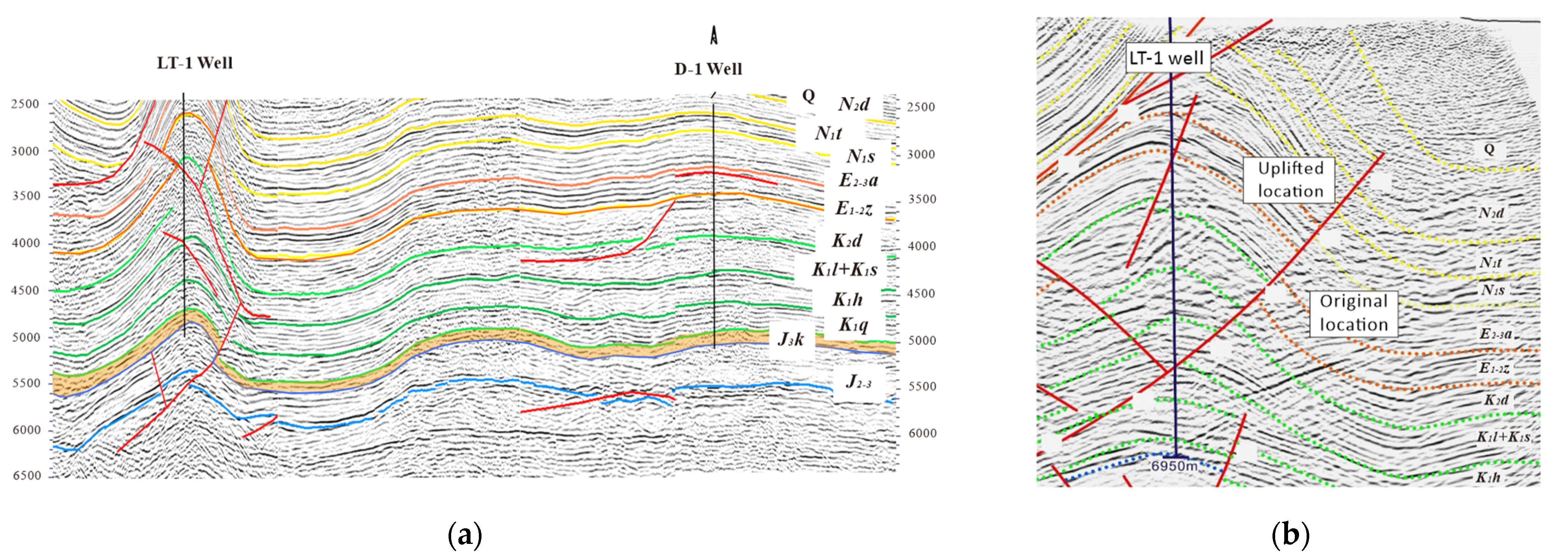
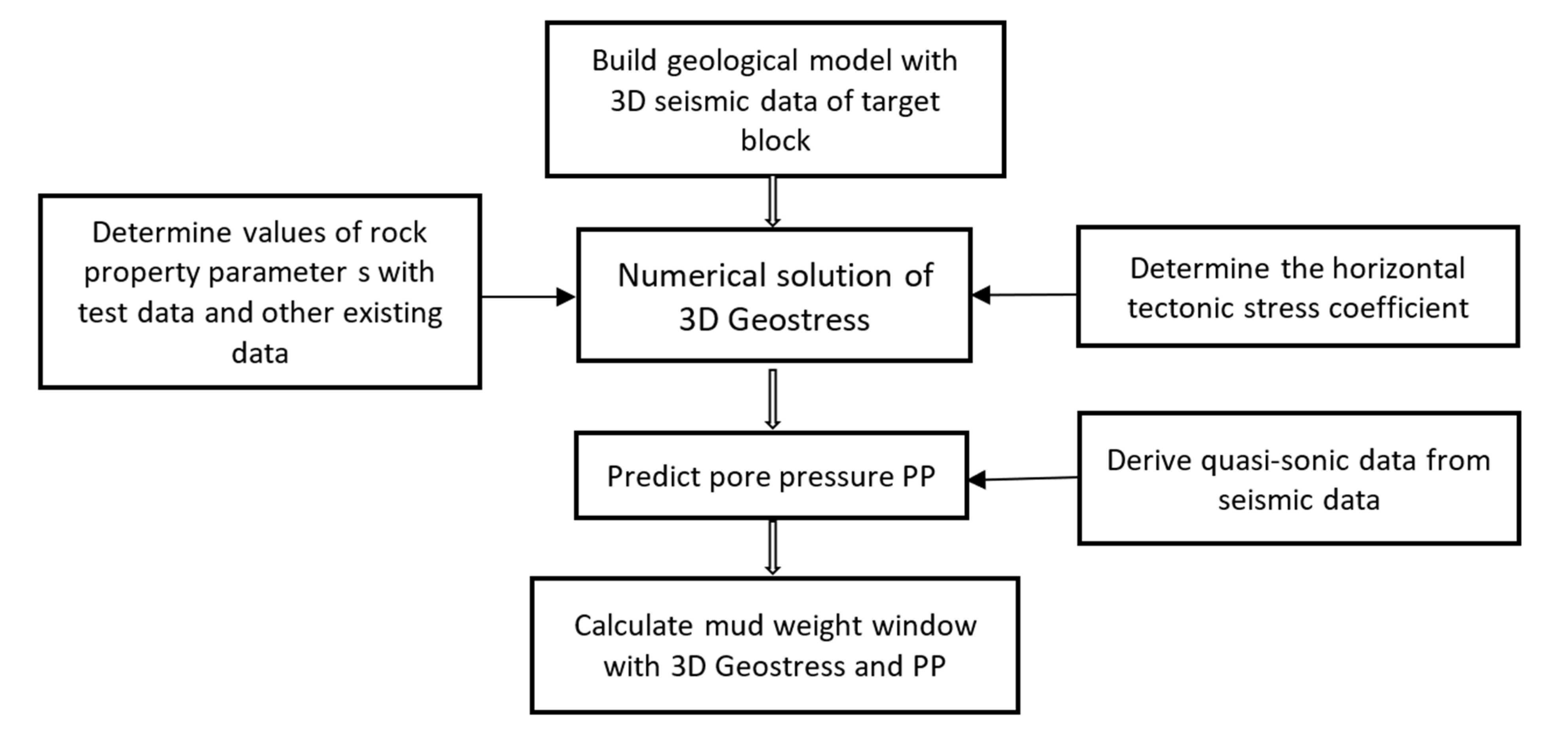

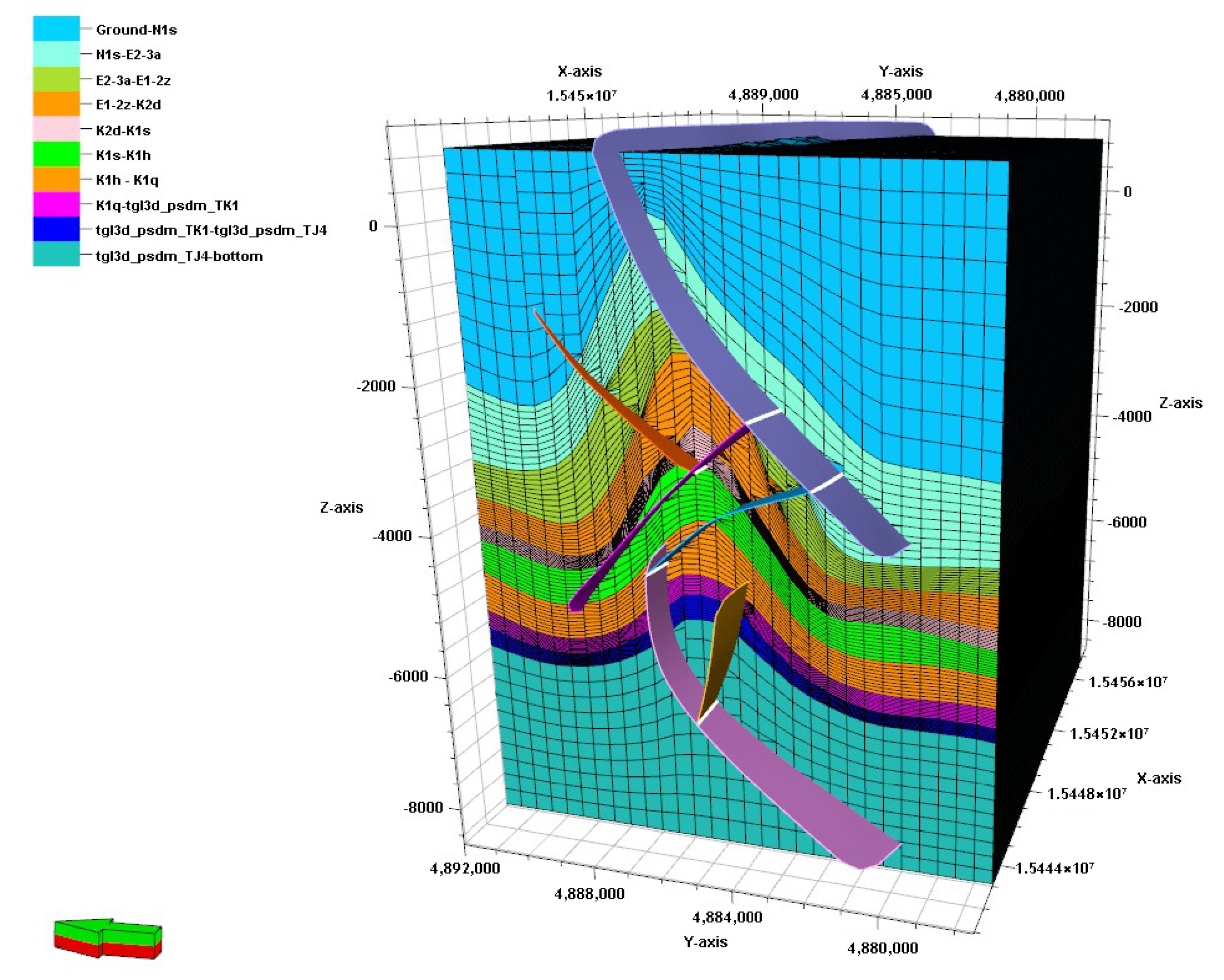

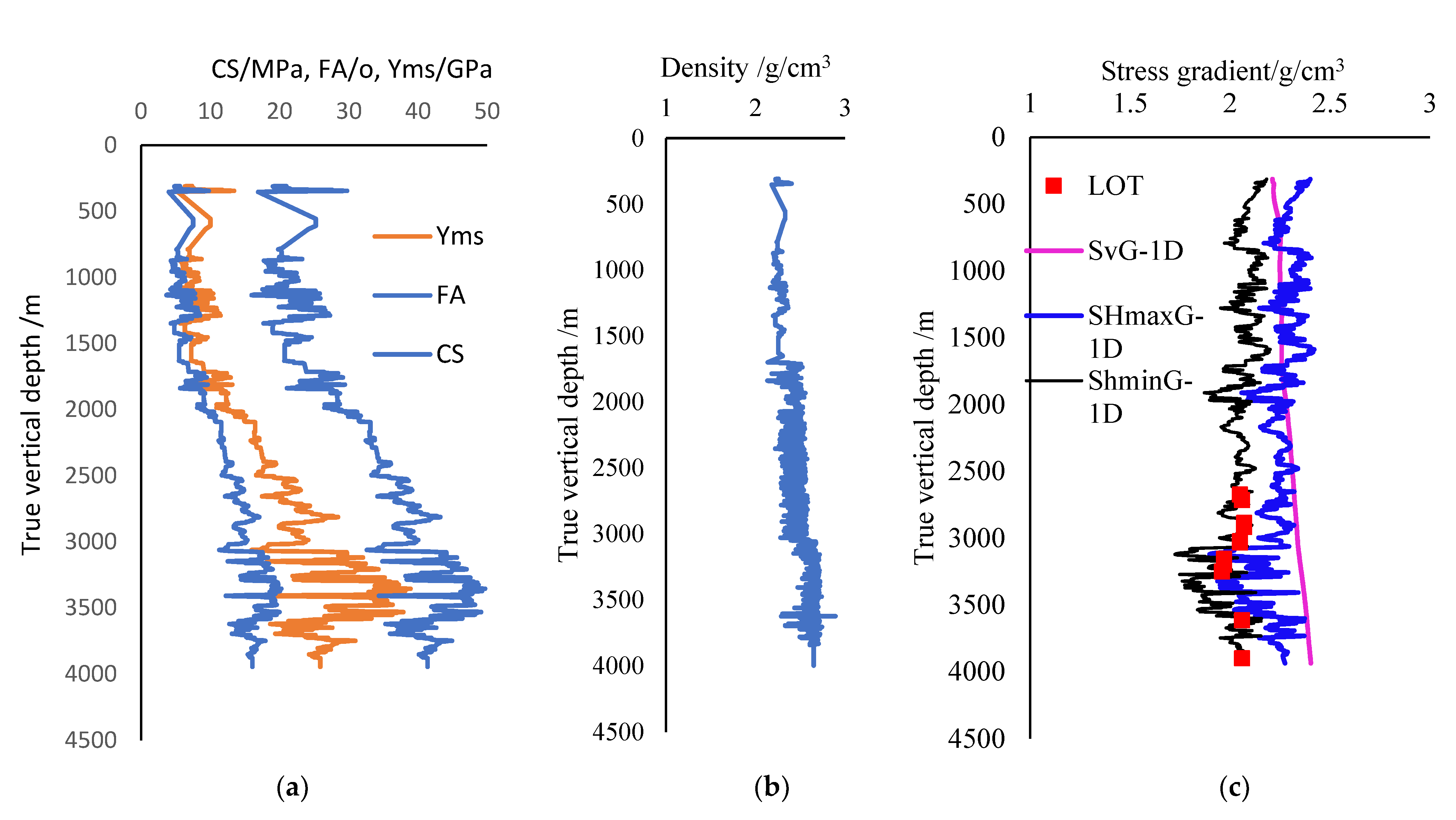
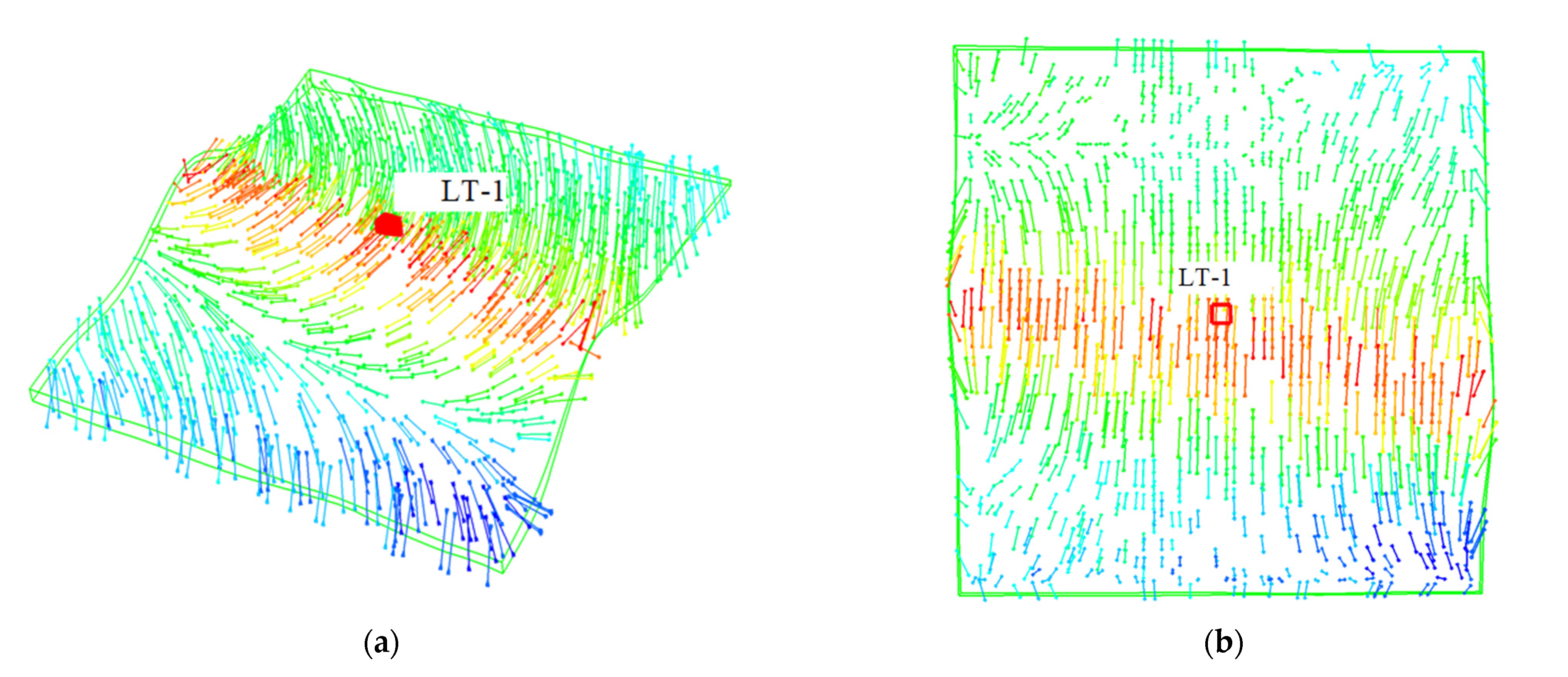

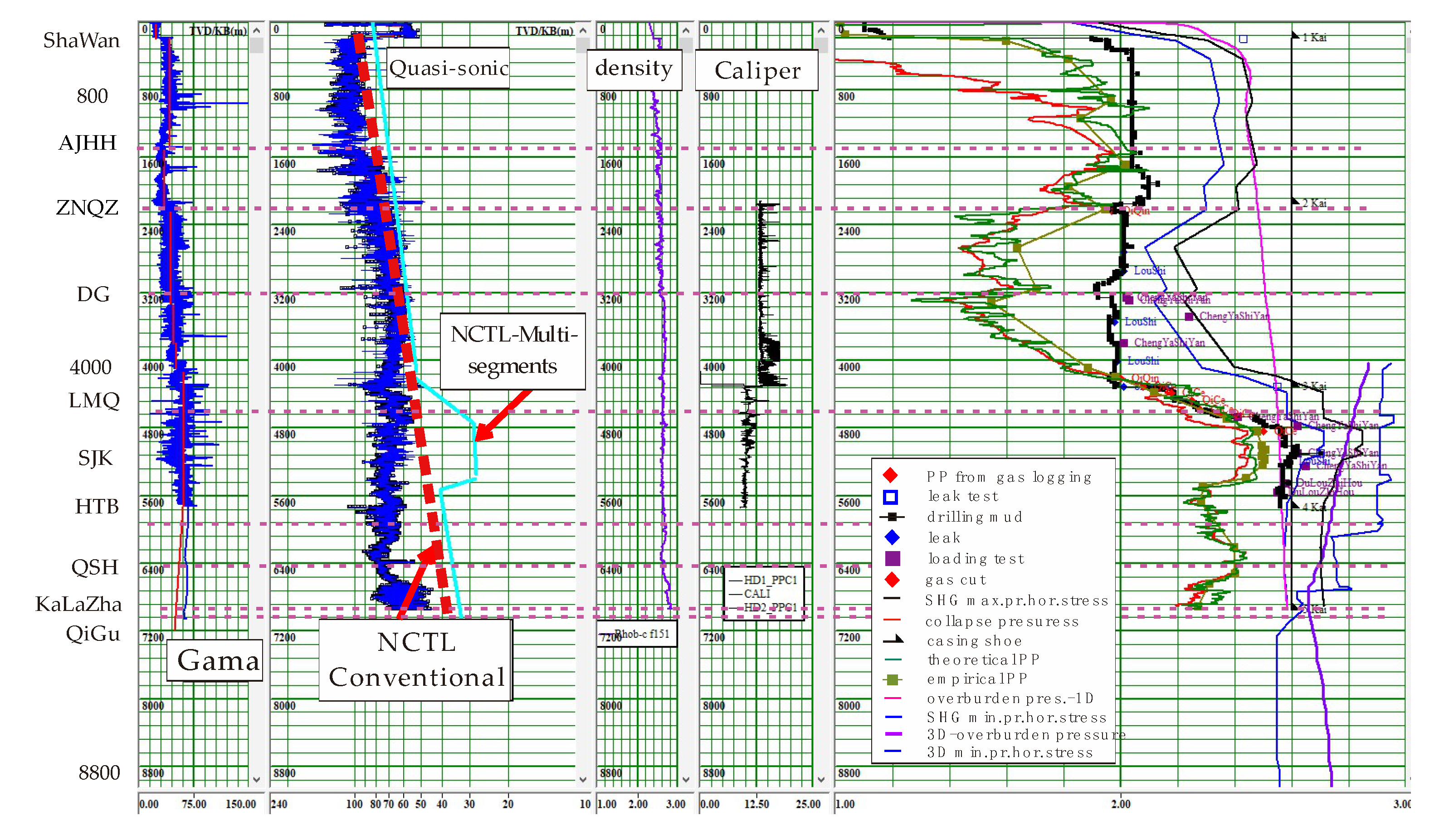
| Formation | Symbol | Bottom Depth (m) | Lithology Description | Stratum Dip Angle |
|---|---|---|---|---|
| ShaWan | N1s | 372 | Mudstone with conglomerate, unequally grained sandstone. | 55~65° southward tilt |
| AJHH | Breakpoint 1 | 542 | The upper part is mainly mudstone; the lower part is interbedded with an unequal thickness of mudstone and argillaceous siltstone. | 55~65° southward tilt |
| E2-3a | 1497 | |||
| ZNQZ | E1-2z | 2052 | The upper part is dominated by siltstone, argillaceous sandstone; the lower part is composed of gravel-bearing unequal-grained sandstone and glutenite. | 5~10° northward tilt |
| DG | Breakpoint 2 | 2162 | Gravel-bearing unequal-grained sandstone, glutenite, fine sandstone, siltstone, and argillaceous sandstone. | 5~15° northward tilt |
| K2d | 2947 | |||
| LMQ + SJK | K1l + K1s | 3847 | The upper part is siltstone and sandy mudstone; the lower part is interbedded with argillaceous siltstone, gray mudstone and siltstone. | 5~15° northward tilt |
| HTBH | K1h | 4627 | The upper part is dominated by argillaceous siltstone; the lower part is dominated by brown mudstone and silty mudstone. | 5~15° northward tilt |
| QSH | K1q Breakpoint | 5327 | Mudstone and argillaceous siltstone interbedded. Light gray powder-fine sandstone and fine sandstone developed at the bottom. | 5~15° northward tilt |
| HTBH2 | K1h | 5922 | The upper part is mainly grayish brown argillaceous siltstone; the lower part is composed of brown mudstone and silty mudstone. | 5~15° northward tilt |
| QSH2 | K1q | 6660 | Mudstone and argillaceous siltstone interbedded. Light gray siltstone fine sandstone and fine sandstone are developed. | 5~20° northward tilt |
| KaRaZha | J3k | 6920 | Dominated by thick-layered light gray sandy conglomerate. | 5~20° northward tilt |
| QiGu | J3q | 6950 | Dominated by layers of brown mudstone and sandstone with medium-thick layers of gray–green siltstone and fine sandstone. | 5~20° northward tilt |
| TVD/m | k0 |
|---|---|
| 197 | 0.8 |
| 2722 | 0.6 |
| 3000 | 2 |
| 3480 | 2 |
| 3551 | 2 |
| 4008 | 2 |
| 4309 | 2 |
| 4772 | 2 |
| 4808.37 | 3 |
| 5100 | 3.5 |
| 5135.39 | 3 |
| 5244 | 2 |
| 7105.57 | 1 |
| Formation | Formation Bottom Depth/m | Pore Pressure Gradient g/cm3 | Shear Failure Gradient g/cm3 | Fracture Gradient g/cm3 | Mud Weight Window g/cm3 |
|---|---|---|---|---|---|
| Shawan N1s | 172 | 1.0–1.1 | 1.0 | 1.85–2.0 | 1.1–1.85 |
| AJHH E2-3a | 188 | 1.0–1.1 | 1.0 | 2.0–2.1 | 1.1–2.0 |
| AJHH2 E2-3a | 1474 | 1.7–1.9 | 1.0–1.9 | 2.2–2.3 | 1.9–2.2 |
| ZNQZ E1-2z | 2100 | 1.8–1.98 | 1.75–1.98 | 2.3–2.35 | 1.98–2.3 |
| DG K2d | 2147 | 1.98 | 1.8 | 2.13 | 1.98–2.13 |
| DG2 K2d | 3250 | 1.6–1.97 | 1.45–1.9 | 2.05–2.23 | 1.97–2.05 |
| LMQ K1l | 4309 | 1.5–1.99 | 1.4–1.99 | 2.1–2.58 | 1.99–2.1 |
| LMQ2 K1l | 4578 | 1.99–2.3 | 1.99–2.25 | 2.68–2.81 | 2.25–2.68 |
| SJK K1s | 5240 | 2.3–2.55 | 2.3–2.45 | 2.74–2.79 | 2.55–2.74 |
| HTBH K1h | 5746 | 2.25–2.5 | 2.3–2.45 | 2.65–2.77 | 2.5–2.65 |
| HTBH2 K1h | 5922 | 2.25–2.35 | 2.25–2.35 | 2.63 | 2.35–2.63 |
| QSH K1q | 6660 | 2.3–2.4 | 2.3–2.4 | 2.61 | 2.4–2.61 |
| KaLaZha J3k | 6920 | 2.2–2.35 | 2.2–2.35 | 2.55 | 2.35–2.55 |
| QiGu J3q | 6950 | 2.2–2.35 | 2.2–2.35 | 2.5 | 2.35–2.5 |
Disclaimer/Publisher’s Note: The statements, opinions and data contained in all publications are solely those of the individual author(s) and contributor(s) and not of MDPI and/or the editor(s). MDPI and/or the editor(s) disclaim responsibility for any injury to people or property resulting from any ideas, methods, instructions or products referred to in the content. |
© 2023 by the authors. Licensee MDPI, Basel, Switzerland. This article is an open access article distributed under the terms and conditions of the Creative Commons Attribution (CC BY) license (https://creativecommons.org/licenses/by/4.0/).
Share and Cite
Wang, L.; Shen, X.; Wu, B.; Shen, T.; Shi, J. Integrated Analysis of the 3D Geostress and 1D Geomechanics of an Exploration Well in a New Gas Field. Energies 2023, 16, 806. https://doi.org/10.3390/en16020806
Wang L, Shen X, Wu B, Shen T, Shi J. Integrated Analysis of the 3D Geostress and 1D Geomechanics of an Exploration Well in a New Gas Field. Energies. 2023; 16(2):806. https://doi.org/10.3390/en16020806
Chicago/Turabian StyleWang, Linsheng, Xinpu Shen, Baocheng Wu, Tian Shen, and Jiangang Shi. 2023. "Integrated Analysis of the 3D Geostress and 1D Geomechanics of an Exploration Well in a New Gas Field" Energies 16, no. 2: 806. https://doi.org/10.3390/en16020806
APA StyleWang, L., Shen, X., Wu, B., Shen, T., & Shi, J. (2023). Integrated Analysis of the 3D Geostress and 1D Geomechanics of an Exploration Well in a New Gas Field. Energies, 16(2), 806. https://doi.org/10.3390/en16020806







